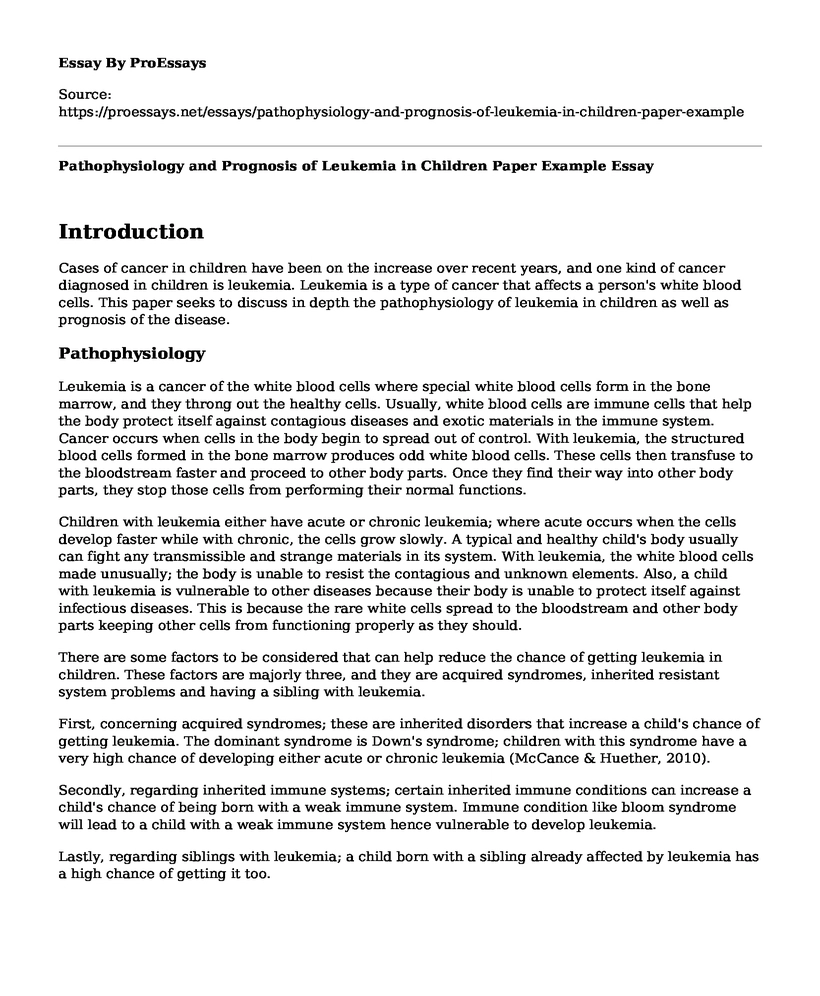Introduction
Cases of cancer in children have been on the increase over recent years, and one kind of cancer diagnosed in children is leukemia. Leukemia is a type of cancer that affects a person's white blood cells. This paper seeks to discuss in depth the pathophysiology of leukemia in children as well as prognosis of the disease.
Pathophysiology
Leukemia is a cancer of the white blood cells where special white blood cells form in the bone marrow, and they throng out the healthy cells. Usually, white blood cells are immune cells that help the body protect itself against contagious diseases and exotic materials in the immune system. Cancer occurs when cells in the body begin to spread out of control. With leukemia, the structured blood cells formed in the bone marrow produces odd white blood cells. These cells then transfuse to the bloodstream faster and proceed to other body parts. Once they find their way into other body parts, they stop those cells from performing their normal functions.
Children with leukemia either have acute or chronic leukemia; where acute occurs when the cells develop faster while with chronic, the cells grow slowly. A typical and healthy child's body usually can fight any transmissible and strange materials in its system. With leukemia, the white blood cells made unusually; the body is unable to resist the contagious and unknown elements. Also, a child with leukemia is vulnerable to other diseases because their body is unable to protect itself against infectious diseases. This is because the rare white cells spread to the bloodstream and other body parts keeping other cells from functioning properly as they should.
There are some factors to be considered that can help reduce the chance of getting leukemia in children. These factors are majorly three, and they are acquired syndromes, inherited resistant system problems and having a sibling with leukemia.
First, concerning acquired syndromes; these are inherited disorders that increase a child's chance of getting leukemia. The dominant syndrome is Down's syndrome; children with this syndrome have a very high chance of developing either acute or chronic leukemia (McCance & Huether, 2010).
Secondly, regarding inherited immune systems; certain inherited immune conditions can increase a child's chance of being born with a weak immune system. Immune condition like bloom syndrome will lead to a child with a weak immune system hence vulnerable to develop leukemia.
Lastly, regarding siblings with leukemia; a child born with a sibling already affected by leukemia has a high chance of getting it too.
Prognosis
Prognosis deliberations help doctors who treat children with leukemia decide whether the child should receive standard or intensive treatment. There are two significant factors that doctors consider in treating children with leukemia. These reflections are the initial white blood cells count of the child and the age when the diagnosis is known. According to Ghali (2018), children between one and nine years receive standard treatment while those younger than one year, or ten years and above, they receive intensive treatment. Children having a white blood cell count are at high-risk patients thus requiring intensive treatment (Jayavaradhan & Malik, 2018). Conversely, children with low white blood cell count will receive standard treatment.
Conclusion
Conclusively, being diagnosed with cancer is not easy, and it can be worse for children because of their immune systems. However, thanks to technology and advances made in research and medicine field, a child can be treated and taught how to live with leukemia.
References
Ghali, H. H. (2018). The Effectiveness of Modified UKALL protocols in Children with Acute Lymphoblastic Leukemia; an experience of Children Welfare Teaching Hospital. Mustansiriya Medical Journal, 13(2), 8-8.
Jayavaradhan, R., & Malik, P. (2018). Genetic therapies for sickle cell disease. Pediatric clinicsof North America, 65(3), 465-480.
McCance, K. A. & Huether, S.E. (2010). Pathophysiology: The biologic basis for disease inadults and children (7th ed.). St. Louis: Mosby. (Chapters 14, 23-26)
Cite this page
Pathophysiology and Prognosis of Leukemia in Children Paper Example. (2022, Oct 03). Retrieved from https://proessays.net/essays/pathophysiology-and-prognosis-of-leukemia-in-children-paper-example
If you are the original author of this essay and no longer wish to have it published on the ProEssays website, please click below to request its removal:
- Applying Evidence Based Practice in a Group: Adults in Recovery from Domestic Violence
- Emergency and Standby Power Supplies for Buildings Paper Example
- Essay Example on Nurses: Enhancing Competence, Integrity and Social Determinants of Health
- Essay Example on 400K Lives Lost: The Opioid Crisis in America
- Essay Example on Ethics of Randomized Clinical Trials: Arguing for RCTs
- Essay Example on Global Women's Health: Mamma Seesay's Story
- Malaria - Free Essay Example







